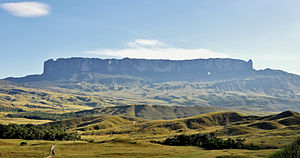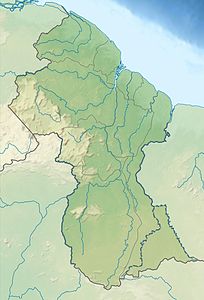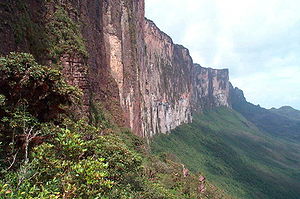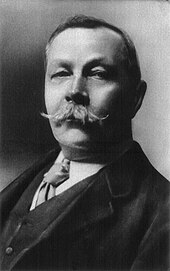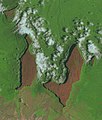Roraima tepui
| Roraima tepui | ||
|---|---|---|
|
Roraima tepui |
||
| height | 2810 m | |
| location | The triangle of Venezuela , Brazil and Guyana | |
| Mountains | Tepui | |
| Coordinates | 5 ° 10 '59 " N , 60 ° 45' 59" W | |
|
|
||
| Type | Table Mountain | |
| rock | Sandstone | |
| Age of the rock | about 2 billion years | |
| First ascent | 1884 by Everard Im Thurn | |
|
The steep rock face of the Roraima-Tepui |
||
The Roraima tepui (from Pemón roroi 'turquoise blue', 'fertile', ma 'large'), Portuguese and Spanish Monte Roraima or Cerro Roraima , is a 2,810 m high tepui in the triangle between Venezuela , Brazil and Guyana .
He is the namesake of the Brazilian state of Roraima . Until 1962, the region was called Território do Rio Branco , but there were repeated misdirections of letters and immigrants who wanted to this region, but finally arrived in the then capital Rio Branco of the Acre territory.
Location and dates
In the Gran Sabana there are 115 tepuis ( table mountains formed by erosion ), of which the Roraima tepui and the Auyan tepui are the best known. The largest extension of the Roraima plateau is about 15 km and rises up to 700 meters above the tropical rainforest . To the west of Mt. Roraima is the twin tepui Kukenam .
The landscape on the high plateau is a rock labyrinth with many gorges - some hundreds of meters deep - and not a plateau, as was previously assumed. The sandstone consists of 95 percent pure quartz and is traversed by many hydrothermal quartz veins. Therefore, on the surface, you can always find floods made up of small quartz crystals and entire crystal steps that come from these corridors. The area is part of a national park, so it is forbidden to take any minerals from the Roraima.
fauna and Flora
Lichen, grasses, Stegolepis guianensis , Orectanthe sceptrum and various orchids mainly grow on the Tepuis plateau . The nutrient-poor sandstone soil is also ideal for carnivorous plants such as marsh jugs , trap traps and sundew species . The animal world consists of insects, birds, amphibians ( e.g. Oreophrynella quelchii ) as well as smaller reptiles (snakes, lizards) and mammals (mice). About 80 percent of all organisms on the Roraima are endemic ; H. it is a unique animal and plant world that only occurs on the tepui, as it cannot be found in any other place in the world. One cause is the steep wall several hundred meters high, which represents an insurmountable barrier, and another is the different climate, which leads to thermal insulation from the rainforest. On the ground there is a humid, tropical climate (≈ 30 ° C), while on the plateau it is more moderate (≈ 10 ° C) with different weather conditions.
Emergence
For a long time it was impossible to date the origin of the Roraima tepuis. The sandstone does not contain any fossils that could be used to determine its age. In the 1980s, special rock inclusions were discovered that came from deep layers of the earth and were transported up through cracks in the sandstone, where the ember-like mass solidified. This rock contains radioactive elements such as uranium , which breaks down into lead after a few billion years. The time of solidification can be determined using uranium-lead dating . The sandstone inclusions showed an age of 1.8 billion years. However, since this only indicates when the rock solidified, the Tepui sandstone itself must be significantly older. Geologists suspect that the Tepui sandstone was formed 2 billion years ago. The division of the Tepuis sandstone into Roraima and Kukenam probably happened 160 million years ago when the great continent Gondwana broke up and South America drifted westward. A tremendous earthquake was probably the cause of this division.
history
The local Indians never tried to climb the Roraima-Tepui, and even the explorers of the 18th and early 19th centuries could only speculate what was on the high plateau. One suspected extinct animal species (even dinosaurs ) that would have survived there. Several naturalists , geographers , botanists and anthropologists explored the area around the Roraima, such as Richard and Robert Schomburgk (between 1838 and 1844), Ernst Ule (1909/10) and Theodor Koch-Grünberg (1911). In 1884 the British explorer Everard Im Thurn managed to climb Mount Roraima for the first time. He found only herbs and bushes. At the end of the 19th century there was a conflict when Great Britain wanted to annex the region of the Tepuis from British Guyana , because mineral resources (e.g. diamonds) were found in the area . However, they withdrew again at the request of US President Grover Cleveland . In 1899 an international tribunal was convened in Paris to clarify the border dispute. It was decided that most of the area (including Roraima) belonged to British Guiana. Since access to this day is only possible from the Venezuelan side, the British were unable to develop the area.
In 2010 an expedition with Stefan Glowacz succeeded in the first ascent of the route “Behind the Rainbow” (IX + / X-), a route through the overhanging rock faces of the mountain. Glowacz, Holger Heuber and Kurt Albert were on the road for two weeks, using dugout canoes on rivers and then on foot to get to the mountain. Because the ascent was too steep and dangerous for them, the locals, who had been hired by the climbers to help transport the heavy equipment, started their way back early. The film Hunter of the Moment - An Adventure on Mount Roraima was made about the expedition in 2013 .
The Lost World
Reports by the famous South America researcher Sir Robert Hermann Schomburgk inspired the English country doctor and writer Arthur Conan Doyle to write a novel The Lost World (1912) about the discovery of a living prehistoric world full of dinosaurs and primeval plants. Arthur Conan Doyle never mentions the name Roraima in his book. In the novel, Table Mountain is considered impassable. The characters in the novel manage to get to the plateau only through a trick, namely by climbing a rock needle in front of them and crossing the gorge with a felled tree. This rock needle also exists in reality, but it is more than just a tree's length away from the plateau.
Picture gallery
Web links
Individual evidence
- ↑ Stephanie Geiger: Where there are still real adventures , in: Welt am Sonntag, April 20, 2013
